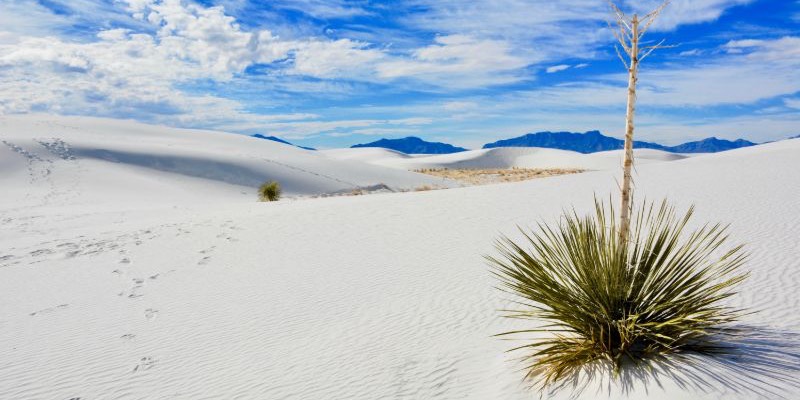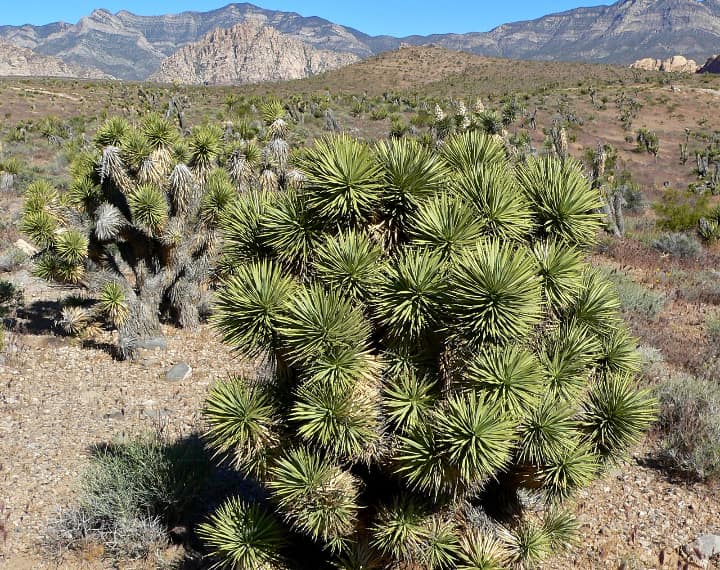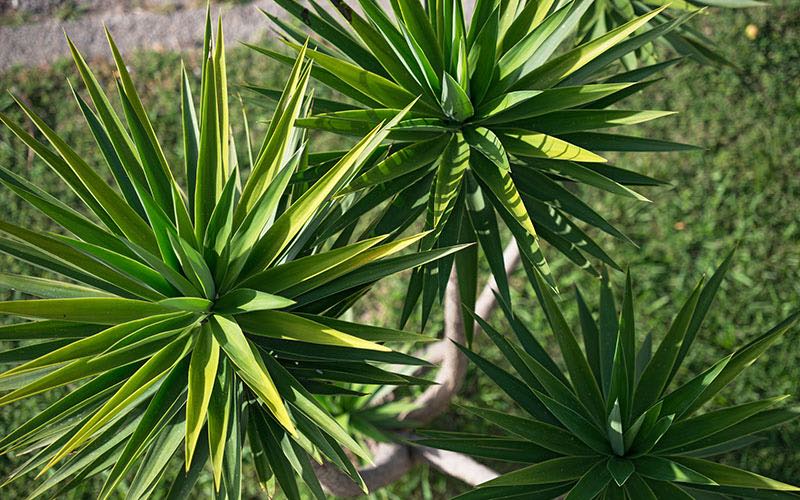Looking for a striking plant that’s super easy to care for? Yucca plants are not your average plants. With their interesting, often startling look and resilient nature, they bring cacti to mind, only that they are often a lot more fun-looking and colorful.
Whether you’ve seen Yuccas before or are new to them, we’ve handpicked for you a selection of awesome varieties you can bring into your own home or garden.
Some plants are not as thirsty as others, and Yucca plants are a case in point. Growing in the hot and arid environments of Southern America and the Caribbean, these evergreens won’t be rustling their leaves at the watering can too soon.

In this post, we share with you the best types of Yucca plants to keep in your home as well as useful caring tips. So, let’s get right on to it. Learn more about growing and caring for your own Yuccas.
Popular Types of Yucca Plants
There are over 40 species of Yucca ranging from small shrubs to tall, tree-like plants. That means lots of options for you to choose from!
These beautiful plants can be kept anywhere from your kitchen to your backyard. Explore now the best types of Yucca plants so you can decide which one is perfect for you!
1. Spineless Yucca Plant (Yucca elephantipes)
Spineless Yucca can grow up to 30 feet, hence its nickname the “Giant Yuca”. But it’s more commonly grown as a small potted plant. It’s the most common variety of Yucca grown as indoor plants.

Its spineless leaves make it a safe plant to grow indoors. During summer, spineless yucca blooms white flowers that will grow into fruits.
2. Red Yucca Plant (Hesperaloe parviflora)
Native to Central America, Red Yucca plants are great additions to outdoor gardens. With their vivid colors and rich texture, they create a striking contrast.
Named after its pinkish cluster flowers which grow atop tall slender spikes, this kind of Yucca plant grows like a grass and is highly tolerant of drought. An evergreen, it blooms all year round and is perfect for sun-drenched gardens.

3. Yellow Yucca Plant (Hesperaloe parviflora yellow)
A cousin of the Red Yucca is the Yellow Yucca, which is native to Southwestern America. It’s often planted next to the Red Yucca to create lovely bi-colored gardens. This particular species blooms until fall.
Like the Red Yucca, its beauty lies in its cluster of trumpet-like yellow flowers that can grow up to 5 feet long. These attract hummingbirds, so the red and yellow Yuccas are also known as “Hummingbird Yuccas”.

4. Adam’s Needle (Yucca filamentosa)
Native to Southeastern USA, Adam’s Needle Yucca has been used not just in landscaping. Native Americans used its fibrous leaves for clothing and the roots for shampoos.
It gets its name from its sharp-tipped leaves, which grow up to 4 feet tall. A trunkless variety of Yucca, Adam’s Needle often servers as a specimen plant or else grows in fire-proof gardens. Its lantern like-white flowers grow in the spring.

5. Joshua Tree (Yucca brevifolia)
Yucca brevifolia or Joshua Tree Yucca is the largest variety of Yucca plants. The Joshua tree was named by Mormon pioneers due to its sturdy tree-like appearance which reminded them of the story from the Old Testament of the prophet Joshua.
In the wild, the Joshua tree grows exclusively in the Mojave Desert at the elevation of at least 2,000 feet. But you can grow it at home using dry sand-like soil and keeping it in a hot climate.

Good to know: Growing up to 40 feet and living up to 150 years (it can mature in 50-60 years), the Joshua Tree is not your average yucca!
6. Blue Joshua Tree (Yucca brevifolia blue)
Yucca brevifolia is nicknamed the Blue Joshua Tree due to its resemblance in structure to the Joshua Tree.
One of the most sought-after outdoor Yucca plants, the blue Joshua tree brings instant beauty to any garden with its sharp bluish-purple leaves.
7. Dwarf Joshua Tree
A more common Yucca variety is the dwarf Joshua Tree, Yucca brevifolia. This looks identical to the Joshua tree but its a shorter version, growing to a maximum of only 12 feet.

Its branches are also more compact unlike the spread-like branches of the Joshua tree. When this species blooms in spring, it produces beautiful ivory bell-shaped flowers.
8. Soapweed Yucca Plant (Yucca glauca)
Also known as the Yucca glauca, this type of Yucca plant grows in central North America throughout desert grasslands. Its sharp tall leaves grow up to 4 feet tall and the roots of these plants are sometimes used to make soaps.
As an evergreen shrub, Soapweed Yucca is a great all-season landscape plant with its beautiful rosette-forming blue-green leaves. When in bloom between June and August, it has green and white fragrant flowers.

9. Spanish Dagger (Yucca aloifolia)
Another southeastern US native, the Yucca aloifolia or the Spanish Dagger is a favorite outdoor ornamental plant. It gets its name from its sword-like foliage.

With its unique growth pattern and flowers, this variety of Yucca plant is used in landscaping as an accent or background plant. This species blooms from June till July and can grow up to 12ft.
10. Beaked Yucca Plant (Yucca rostrata)
Also known as the Big Bend Yucca, the Beaked Yucca is characterized as a single trunk yucca with its iconic pom-pom-shaped sharp, pale blue leaves.

This cactus-like plant has soft thin gray fibers draping from its old leaves giving an illusion of a silvery haze.
When in bloom, the Beaked Yucca has yellow-orange flowers. It’s one of the most handsome yucca plants you can grow, and it’s widely used in Mediterranean and gravel gardens.
11. Bear Grass Yucca (Yucca filamentosa)
Similar to Adam’s Needle, Bear Grass Yucca is one of the few varieties of Yucca plant that has adapted to extreme cold and even frost. It grows even in the colder climates of British Columbia and Alberta, Canada.

Though Bear Grass and Adam’s Needle Yuccas may look almost the same, Bear Grass has softer leaves. Bear Grass Yucca also grows head-shaped white flowers when in bloom.
Fact: The name comes from the fact that in the wild, young bears like to eat the plant’s stems.
12. Banana Yucca Plant (Yucca baccata)
Some Yuccas have edible stems, flowers, and fruits. Banana Yucca is a species that grows edible fruits.

Its banana-shaped fruits (guess where the name comes from?) are soft and succulent and have been traditionally eaten by Navajo and Apache Indians. Like most Yucca plants, its leaves are sharp and it grows flowers in spring.
13. Mojave Yucca Plant (Yucca schidigera)
One of the bigger varieties of Yucca plants is the Mojave Yucca. Since it belongs to the same genus as the Joshua tree, Mojave Yucca has a tree-like structure and a distinct cane trunk.

Commonly found in the Mojave Desert, it grows up to 16 feet and, with its sharp-edged leaves, can be planted in a big pot as an accent to a large open space.
Tip: Well known for its traditional medicinal uses, the roots of this plant are edible and beneficial for human health, boosting immunity, benefiting skin health, and helping soothe arthritis.
14. Spanish Bayonet (Yucca aloifolia)
This aptly named Yucca has dramatic sharp leaves and flowering spikes, making it easy to distinguish. It can grow up to 15 ft.

One of the more common Yucca plants used in bigger gardens, the Spanish Bayonet is also the best choice for gardens near the coast, as this variety is resistant in salty environments.
15. Color Guard
One of the varieties of Adam’s Needle, the Color Guard Yucca plant is great for both indoor and outdoor use.
Like most shrubby-type of Yucca, it’s great as a houseplant. Once it matures and grows bigger, you can move it into your garden. Its stunning foliage is green with a striking yellow stripe down the center with bright pink margins.

16. Soaptree Yucca (Yucca elata)
Soaptree Yucca originates from the Chihuahuan Desert but is now a common sight in gardens around the world.

Its palm-like leaves, white flowers, and proud height make it a favorite ornamental plant in outdoor gardens. Its trunk and roots were once used by Native Americans to make soaps.
17. Thompson’s Yucca Plant (Yucca thompsoniana)
With its single or dual trunk and pom-pom-like foliage, Yucca thompsoniana is often mistaken for the Beaked Yucca. However, Thompson’s Yucca is smaller and can only reach 6 feet at most.

It’s quite a beauty with its nice shape and cute look and can accentuate space indoors as well as make your garden more interesting.
Yucca Plant Guide: How to Care for Yuccas
One of the reasons we like to buy and care for Yucca plants is their reputation for being low-maintenance.
They have a high tolerance for extreme conditions, such as drought, hot and arid environments, and even cold weather. In other words, it’s the perfect plant if you got a busy life and easily forget to water your plants.
Light
When taking care of Yuccas indoors, make sure they receive enough sunlight. Although tolerant of different environments, they need plenty of sunlight to grow.

Watering
How often should you water your Yucca plant? Since Yuccas are native to dry soil and drought-resistant, you don’t have to water them every day.
Important: Between waterings, allow the soil to become dry, otherwise you’ll overwater it.
Overwatering is one of the main reasons a Yucca plant dies. If you notice brown ends on drooping leaves and a foul smell rising from the roots, then you are definitely overwatering your Yucca plant.
Soil
The optimal soil for this plant should have a 3:1 sand to peat ratio. If you buy a Yucca in a pot, you can leave it in the soil it came from if it does well, but in time consider moving it to a larger pot with optimal soil.

Important: Make sure water drains easily from the pot since these plants don’t thrive in moist and watery soil.
Fertilizer
As slow-growing plants, Yuccas don’t need to be fertilized often. But it’s good to use once or twice a year a well-balanced nitrogen fertilizer to boost your plant’s health and growth.
Pruning
Keep your Yucca plants clean and healthy by dusting them over once a week with a feather duster or similar implement. Remove old and dry leaves to keep them fresh and healthy-looking.
Yucca Plant Benefits
Yucca plants are great houseplants and beautiful landscape features. They are beneficial in a number of ways. Here are the benefits of having a yucca plant:
- Yuccas are great air purifying plants
- Yucca roots have medicinal properties that help to control blood sugar, relieve stress, and soothe joint pain
- Yuccas may reduce inflammation in the body
- You can use their leaves for DIY handiwork, like custom-woven baskets
- Red and Yellow Yuccas attract hummingbirds, giving more life to your garden
- Last but not least, placing yuccas with sharp leaves below windows can increase your security (burglars won’t see this one coming!)

As noted, the benefits of Yucca plants are not the only reason these plants became popular.
These plants have served various cultures for centuries, most notably Native Americans, who’ve used their fruits as food and made soaps and wove baskets from their roots and leaves.
Are Yucca Plants Pet Safe?
The Yucca plant contains steroidal saponins that are toxic to cats and dogs. If your furry pets chew on the leaves, they may experience constipation or vomiting.
But most varieties have sharp leaves and a hard trunk, which won’t encourage pets to nibble at them.

However, there is one exception: the Spineless Yucca. This shrub is one of the most common houseplants to have and due to its softer leaves, your pets might be drawn to it.
Tip: If you have a plant-eating pet, you may want to avoid the Spineless Yucca and choose instead a sharper Yucca plant. It’s for your pet’s own good!
If you have a Yucca and notice signs of pet poisoning like dizziness, lack of appetite, weakness, and dilated pupils make sure to call your veterinarian or pet poisoning hotline.
Yucca Plants FAQ
We hope this list of commonly asked Yucca plant questions can help you with anything you might be wondering.
How do you care for a yucca plant?
Yucca plants will do well as long as they have plenty of water. They are easy to grow and very hardy. They love the sun, but they can handle a little shade as well.
Can you grow yucca plants outside?
Yes, of course! Yucca plants can grow in harsh environments like deserts, so you can easily grow them in your garden. Just make sure they get enough sunlight and that you don’t overwater them. Find out more yucca care tips.
How long can a yucca plant live?
Yuccas have quite a long lifespan. They can live five years or more in a pot. Tree varieties can live for much longer. In the end, how long your Yuccas live depends on how well you care for them.
What are yucca plants good for?
Yuccas can brighten up any room and add an exotic touch to your garden. Their roots have medicinal properties that help soothe arthritis, treat diabetes, and reduce stomach inflammation. Yuccas also purify the air. Explore more Yucca plant benefits.
Choose the Right Yucca Plant for You
Yuccas have what it takes for them to become your new favorite plants. Whether you pick a shrub or tree-like variety, Yuccas bring greenery and freshness into your life.
There are plenty of types of Yucca to choose from, and it’s wise to pick one that suits your taste and purpose. Take your time to explore all your options.
Do you want indoor plants only? You could pick a Spineless Yucca, provided you don’t have any plant-eating pets around.
But if you got plenty of space in your garden, get some Spanish Bayonets or even a Joshua tree to add an exotic feel to your garden.
Whatever Yucca plant you choose, we’d love to hear from you. Tells us which caught your fancy and why. Until next post!

Can I revive a large about 15 feet tall yucca plant that just fall down and trunk is dark brown ?
It sounds like the trunk is rotting. You will have to remove the whole area that is affected by the rot and repot the plant.
I have a yucca plant that has just grown a long stalk and then branches grew out of it and finger like pods on these. I can send pictures. I would like to know what it is. Grown in Central Florida.
Hey! Could it be a Spanish Dagger or a Banana Yucca plant?